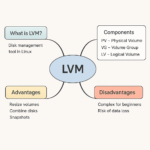🔷 Decimal and Binary Number System with Conversion (English)
✅ 1. Decimal Number System (Base 10)
- It uses 10 digits: 0, 1, 2, 3, 4, 5, 6, 7, 8, 9
- This is the number system we use in daily life.
- Each digit has a place value based on powers of 10.
Example:
524 = (5 × 10²) + (2 × 10¹) + (4 × 10⁰)
= 500 + 20 + 4
✅ 2. Binary Number System (Base 2)
- It uses only 2 digits: 0 and 1
- It is used in computers and digital systems
- Each binary digit is called a bit
- Place values are based on powers of 2
Example:
1011 = (1 × 2³) + (0 × 2²) + (1 × 2¹) + (1 × 2⁰)
= 8 + 0 + 2 + 1 = 11
🔄 Conversions
🔹 A. Decimal to Binary (With Example)
Method: Divide the decimal number by 2 and write the remainders in reverse.
Example: Convert 13 to binary
Step 1: 13 ÷ 2 = 6, remainder = 1
Step 2: 6 ÷ 2 = 3, remainder = 0
Step 3: 3 ÷ 2 = 1, remainder = 1
Step 4: 1 ÷ 2 = 0, remainder = 1
Binary = 1101
🔹 B. Binary to Decimal (With Example)
Method: Multiply each binary digit with power of 2 from right to left and add.
Example: Convert 1010 to decimal
= (1 × 2³) + (0 × 2²) + (1 × 2¹) + (0 × 2⁰)
= 8 + 0 + 2 + 0 = 10
📝 Exam Format Notes
✍️ Q1. Define Decimal and Binary Number System with example.
Decimal Number System:
A number system that uses 10 digits (0–9). It is also called base-10.
Example: 523 = (5 × 10²) + (2 × 10¹) + (3 × 10⁰)
Binary Number System:
A number system that uses only 2 digits (0 and 1). It is also called base-2.
Example: 1011 = (1 × 2³) + (0 × 2²) + (1 × 2¹) + (1 × 2⁰) = 11
✍️ Q2. Convert 18 to binary.
Step 1: 18 ÷ 2 = 9, remainder 0
Step 2: 9 ÷ 2 = 4, remainder 1
Step 3: 4 ÷ 2 = 2, remainder 0
Step 4: 2 ÷ 2 = 1, remainder 0
Step 5: 1 ÷ 2 = 0, remainder 1
Binary = 10010
✍️ Q3. Convert 1101 to Decimal.
= (1 × 2³) + (1 × 2²) + (0 × 2¹) + (1 × 2⁰)
= 8 + 4 + 0 + 1 = 13
🔷 दशमलव और बाइनरी संख्या पद्धति तथा रूपांतरण (Hindi)
✅ 1. दशमलव संख्या पद्धति (Decimal Number System – Base 10)
- इसमें 10 अंक होते हैं: 0 से 9
- हम इसे दैनिक जीवन में उपयोग करते हैं
- प्रत्येक अंक का मान 10 की घातों पर आधारित होता है
उदाहरण:
524 = (5 × 10²) + (2 × 10¹) + (4 × 10⁰)
= 500 + 20 + 4 = 524
✅ 2. बाइनरी संख्या पद्धति (Binary Number System – Base 2)
- इसमें केवल 2 अंक होते हैं: 0 और 1
- इसका उपयोग कंप्यूटर और डिजिटल डिवाइस में होता है
- बाइनरी अंक को बिट (bit) कहते हैं
- इसका मान 2 की घातों पर आधारित होता है
उदाहरण:
1011 = (1 × 2³) + (0 × 2²) + (1 × 2¹) + (1 × 2⁰)
= 8 + 0 + 2 + 1 = 11
🔄 रूपांतरण (Conversions)
🔹 A. दशमलव से बाइनरी में (Decimal to Binary)
तरीका: संख्या को 2 से भाग देते जाएँ और शेषफल (remainder) को उल्टा लिखें।
उदाहरण: 13 को बाइनरी में बदलें
13 ÷ 2 = 6 शेष = 1
6 ÷ 2 = 3 शेष = 0
3 ÷ 2 = 1 शेष = 1
1 ÷ 2 = 0 शेष = 1
उत्तर: बाइनरी = 1101
🔹 B. बाइनरी से दशमलव में (Binary to Decimal)
तरीका: हर अंक को 2 की घात से गुणा करके जोड़ें।
उदाहरण: 1010 को दशमलव में बदलें
= (1 × 2³) + (0 × 2²) + (1 × 2¹) + (0 × 2⁰)
= 8 + 0 + 2 + 0 = 10
📝 परीक्षा के लिए नोट्स (Exam Format Notes)
✍️ प्र.1. दशमलव और बाइनरी संख्या पद्धति को उदाहरण सहित समझाइए।
दशमलव संख्या पद्धति:
यह ऐसी प्रणाली है जिसमें 0 से 9 तक कुल 10 अंक होते हैं। इसे base-10 कहते हैं।
उदाहरण: 523 = (5 × 10²) + (2 × 10¹) + (3 × 10⁰)
बाइनरी संख्या पद्धति:
यह प्रणाली 0 और 1 दो अंकों का उपयोग करती है। इसे base-2 कहते हैं।
उदाहरण: 1011 = (1 × 2³) + (0 × 2²) + (1 × 2¹) + (1 × 2⁰) = 11
✍️ प्र.2. 18 को बाइनरी में बदलिए।
18 ÷ 2 = 9 शेष = 0
9 ÷ 2 = 4 शेष = 1
4 ÷ 2 = 2 शेष = 0
2 ÷ 2 = 1 शेष = 0
1 ÷ 2 = 0 शेष = 1
उत्तर: बाइनरी = 10010
✍️ प्र.3. 1101 को दशमलव में बदलिए।
= (1 × 2³) + (1 × 2²) + (0 × 2¹) + (1 × 2⁰)
= 8 + 4 + 0 + 1 = 13


